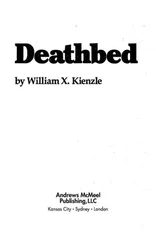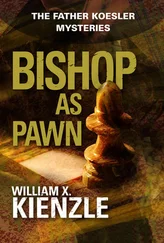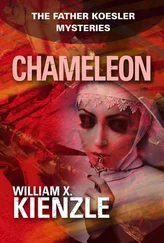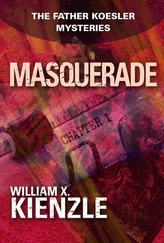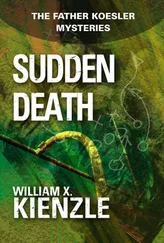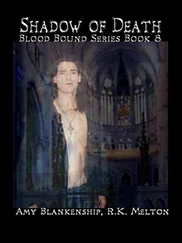Now he was among the heroes. As he walked among the wax figures, Toussaint reflected that the choosing of a hero depended a great deal on who was doing the selecting. He, for one, would never have looked upon tennis player John McEnroe as a hero. More a very spoiled but very wealthy brat.
Toussaint was quite sure—and his hunch was confirmed— that he would not find the Rastafarians’ hero-god here. There was, however, one black man: Muhammad Ali. Strange that with all the achievements of blacks—Paul Robeson, Jackie Robinson, George Washington Carver, Ralph Bunche, Martin Luther King, Jr.—the only black hero was a prizefighter. Well, Ali had claimed to be the greatest. Perhaps he was right.
He had seen it all now except what many considered Madame Tussaud’s piece de resistance, the Chamber of Horrors. Appropriately, this was in the basement.
As Toussaint descended the stairs, he was unaware of the man who furtively removed a sign blocking the ground floor entrance to the chamber stairway. Nor, after Toussaint disappeared into the basement, did he see the man replace the sign in front of the stairway.
The sign read: Temporarily Closed.
The Chamber of Horrors was, quite deliberately, very dimly lit—one of those places wherein it requires several minutes for one’s eyes to adjust to the near-darkness. Toussaint stood motionless at the landing until he could see more clearly. He was then able to discern the general design of the chamber.
It was laid out in a serpentine manner occasionally opening into larger compartments. Many of the exhibits had been set in large alcoves in the walls, the twisting nature of which tended to shield the displays, thus intensifying the viewer’s shock.
He was greeted by the wax image of five human heads that had been severed by the guillotine during the French Revolution: Louis XVI, Marie Antoinette, Hebert, Carrier, and Fouquier-Tinville.
The heads were spattered with varying amounts of blood. Toussaint recalled the custom of the executioner’s holding up a freshly severed head and exhibiting it to the crowd. There was no questioning this exhibit’s stark realism.
Toussaint moved along the corridor. There was the infamous Marat, murdered in his bath in 1793. And John Christie, his shirtsleeves rolled up as he busied himself in the kitchen of the house wherein he had concealed the bodies of his wife and five other women he had murdered. And there was Dr. Crippen in the dock with his paramour beside him. He had murdered his wife and attempted to flee England with his mistress disguised as a boy.
As he continued down the corridor, Toussaint heard noises intended to evoke a London street of the previous century. There was the sound of a horse-drawn carriage and the muffled speech of passersby. This was punctuated by the muted echo of a woman’s scream. There was even a bit of fog. Toussaint peered into the exhibit. It was one of Jack the Ripper’s disemboweled victims. Gruesomely graphic. He wondered if such depictions might not be nightmarish for impressionable children as well as for normally squeamish adults.
The thought of children and adults made him aware that he had seen no other living person in the Chamber of Horrors since he had entered. True, he had not encountered that many people on any of the floors above. But there had been some. And the chamber was supposed to be the most popular section in the museum. He thought it odd, but no more than odd, that he had encountered no one else down here. He shrugged; he would undoubtedly find someone else at the turn of one of these bends.
He recalled the story of the next exhibit clearly. It conjured up the interesting case of one George Joseph Smith. In 1915, Smith was arrested on a “holding charge” of suspected insurance fraud. The police strongly suspected he had murdered his wife, whose insurance he was trying to collect. One Inspector Neil was convinced that Smith, under three different aliases, had murdered three of his wives for their insurance.
Each woman had died in the same manner: by drowning in her bath. And in each case there were no marks of violence. Local doctors had listed the cause of death in each case as heart failure—in one case possibly due to epilepsy. One curious circumstance—again common to all—was that each was found lying with her head under the water at the sloping end of the tub with her legs sticking out the other end.
A pathologist later testified that an epileptic attack causes the body to first contract and then stretch out—which would have pushed the head out of the water. An ordinary faint would have allowed water to enter the mouth and nose and would have had a reviving effect. If the women had fallen forward and drowned, their bodies would have been found face downward, the pathologist concluded.
This same pathologist reexamined the bodies after evidence proved they were all connected to Smith. Still he could find no sign of foul play.
Neil solved the mystery. He experimented with a policewoman volunteer. After she got into a tub identical to those used by Smith, the inspector tried to force her under. Water splashed everywhere and, as she fought him off, it was obvious that if he were to be successful, her body would most certainly show signs of violence . . . which had not been the case with any of the wife-corpses.
Suddenly, he grabbed her feet and yanked upward. As her head went under water, she became unconscious almost immediately. Not until after half an hour’s resuscitation efforts was she able to tell the inspector that the water unexpectedly rushing up her nose had rendered her unconscious.
Smith was hanged.
And now, here was Smith, in waxen form, firmly clutching the ankles of his naked wife as her head disappeared beneath the water, a shocked and horrified expression on her face.
He heard a sound. It wasn’t much of a sound. But it was the first foreign sound, the first sound not suited to any of the exhibits. A clicking sound—like that made when a door is locked.
Toussaint was vividly aware of his solitude. He was alone—or worse, perhaps not alone. But he was isolated; no other tourist was down here, of that he was certain. And that was no longer merely odd, it was ominous.
Perspiration drew his shirt tightly to his back. He took out a clean white handkerchief and touched it to his brow. He sought to moisten his lips, but his mouth was very dry. Seldom had he felt so vulnerable, so impotent. He tried to see around the next bend but, seemingly, the already dim lights had been further turned down. He strained to see a mere few feet ahead of him.
One more step took him into a small, squarish room that seemed to contain five exhibits, though he could see none clearly.
He stepped closer to the nearest exhibit. It showed a man about to be guillotined. He was surrounded by guards. His arms were bound behind his body. His neck was on the block, his head turned slightly sideways. The blade was poised to fall. There was no mistaking it: The victim’s face was that of Toussaint.
A chill knifed through him. Quickly he moved to the next exhibit. Here several men stood atop a gallows. Two guards stood at either arm of the condemned. A priest stood off to one side. The hangman was fitting a noose over the head of . . . Toussaint.
His breathing as well as his heartbeat had become rapid.
He moved to the next exhibit. A dingy Spanish prison cell. A man tied to a stake. An executioner was garroting . . . Toussaint.
To the next. An electric chair. Strapped into the chair was . . . Toussaint.
The final exhibit. A man strapped in a straight-back wooden chair. Pinned to the man’s shirt was a target, the bull’s-eye directly over his heart. The sound of rifles being cocked, fired. The figure in the chair appeared to slump in death. The figure was . . . Toussaint.
Читать дальше




